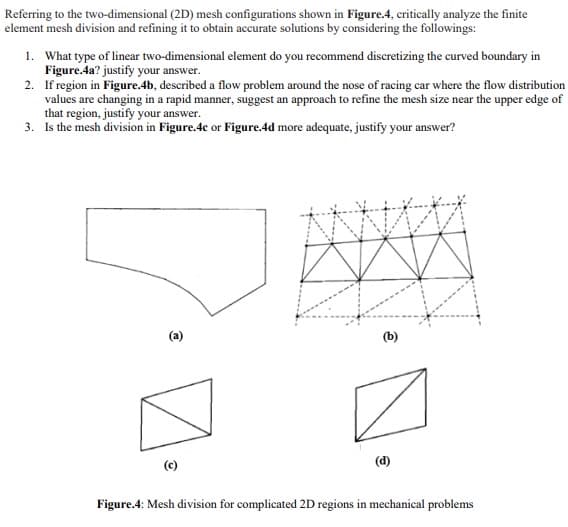1. What type of linear two-dimensional element do you recommend discretizing the curved boundary in Figure.4a? justify your answer. 2. If region in Figure.4b, described a flow problem around the nose of racing car where the flow distribution values are changing in a rapid manner, suggest an approach to refine the mesh size near the upper edge of that region, justify your answer. 3. Is the mesh division in Figure.4c or Figure.4d more adequate, justify your answer?
1. What type of linear two-dimensional element do you recommend discretizing the curved boundary in Figure.4a? justify your answer. 2. If region in Figure.4b, described a flow problem around the nose of racing car where the flow distribution values are changing in a rapid manner, suggest an approach to refine the mesh size near the upper edge of that region, justify your answer. 3. Is the mesh division in Figure.4c or Figure.4d more adequate, justify your answer?
Principles of Heat Transfer (Activate Learning with these NEW titles from Engineering!)
8th Edition
ISBN:9781305387102
Author:Kreith, Frank; Manglik, Raj M.
Publisher:Kreith, Frank; Manglik, Raj M.
Chapter5: Analysis Of Convection Heat Transfer
Section: Chapter Questions
Problem 5.33P
Related questions
Question
I want to answer all the questions by handwriting.

Transcribed Image Text:Referring to the two-dimensional (2D) mesh configurations shown in Figure.4, critically analyze the finite
element mesh division and refining it to obtain accurate solutions by considering the followings:
1. What type of linear two-dimensional element do you recommend discretizing the curved boundary in
Figure.4a? justify your answer.
2. If region in Figure.4b, described a flow problem around the nose of racing car where the flow distribution
values are changing in a rapid manner, suggest an approach to refine the mesh size near the upper edge of
that region, justify your answer.
3. Is the mesh division in Figure.4c or Figure.4d more adequate, justify your answer?
(a)
ê
(d)
Figure.4: Mesh division for complicated 2D regions in mechanical problems
Expert Solution
This question has been solved!
Explore an expertly crafted, step-by-step solution for a thorough understanding of key concepts.
Step by step
Solved in 3 steps with 1 images

Knowledge Booster
Learn more about
Need a deep-dive on the concept behind this application? Look no further. Learn more about this topic, mechanical-engineering and related others by exploring similar questions and additional content below.Recommended textbooks for you

Principles of Heat Transfer (Activate Learning wi…
Mechanical Engineering
ISBN:
9781305387102
Author:
Kreith, Frank; Manglik, Raj M.
Publisher:
Cengage Learning

Principles of Heat Transfer (Activate Learning wi…
Mechanical Engineering
ISBN:
9781305387102
Author:
Kreith, Frank; Manglik, Raj M.
Publisher:
Cengage Learning